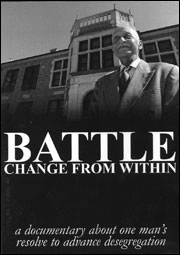This documentary is about educator Eliot Battle and the pivotal role he played in desegregating schools, housing and the Columbia community. As Battle facilitated changes with quiet resolve, he faced resistance from both the black and white communities. His calm demeanor and dedicated work within existing institutions and systems allowed him to bridge the gap between the two races and change Columbia for the better.
About the guide
 This study guide provides examples of what may be used in community settings to enrich viewers’ experience of the documentary. Many of the questions are open-ended so as to stimulate broad and rich discussions that promote peace, understanding, justice, equality and community betterment.
This study guide provides examples of what may be used in community settings to enrich viewers’ experience of the documentary. Many of the questions are open-ended so as to stimulate broad and rich discussions that promote peace, understanding, justice, equality and community betterment.
Questions
Choose from these questions and activities, based upon ages of the audience and the time allotment.
History
- How did the Columbia community’s acceptance of desegregation compare with community reaction in Arkansas?
- How did the experience of the Battle family compare to societal events that occurred in Missouri and across the United States in the 1960s?
- What were some of the challenges experienced by the Battle children as they integrated schools in Columbia?
- How might Dr. Battle be compared to Dr. Martin Luther King Jr.?
- Segregation was a way to keep people of different races apart. Has the situation changed in your community? This DVD discussed one type of diversity — race. What kind of diversity exists in your community, and what challenges occur as a result of that diversity?
Leadership and engagement
- What is community leadership to you? What examples of leadership did you see in this film?
- What did it mean to be a bridge person or to “stand in the gap?”
- Dr. Battle talked about “change from within.” What do you think that means? Does this approach change work in your community?
- What civil rights work still needs to occur in your community? What lessons in civic leadership can be taken from Dr. Battle?
- How can you impact change in your community?
Self-awareness
- What biases or prejudices do I have about those who are different from me?
- What have I said or done “in innocence” that I later learned hurt or harmed someone else?
- Dr. Battle and his family took many risks in the early years. What risks have I taken that have made a difference in my community?
- How can I be an agent for change?
Curriculum guide committee members
- Julie Middleton, director of organizational development, University of Missouri Extension
- Barbara Williamson, associate teaching professor, Department of Educational, School, and Counseling Psychology, University of Missouri College of Education
- Mary Jo Williams, associate state specialist, 4-H Center for Youth Development, University of Missouri Extension
- Nick Kramer, Social Studies Department, Columbia Public Schools
- Eryca Neville, principal, Douglass High School, Columbia Public Schools
- Abbey Trescott, art teacher, Rock Bridge High School, Columbia Public Schools